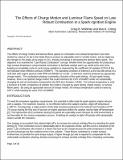| dc.contributor.author | Wildman, Craig B. | |
| dc.contributor.author | Cheng, Wai K. | |
| dc.date.accessioned | 2011-11-03T16:51:36Z | |
| dc.date.available | 2011-11-03T16:51:36Z | |
| dc.date.issued | 2010-04 | |
| dc.identifier.issn | 1946-3944 | |
| dc.identifier.issn | 1946-3936 | |
| dc.identifier.uri | http://hdl.handle.net/1721.1/66904 | |
| dc.description.abstract | The effects of charge motion and laminar flame speeds on combustion and exhaust temperature have been studied by using an air jet in the intake flow to produce an adjustable swirl or tumble motion, and by replacing the nitrogen in the intake air by argon or CO 2 , thereby increasing or decreasing the laminar flame speed. The objective is to examine the “Late Robust Combustion” concept: whether there are opportunities for producing a high exhaust temperature using retarded combustion to facilitate catalyst warm-up, while at the same time, keeping an acceptable cycle-to-cycle torque variation as measured by the coefficient of variation (COV) of the net indicated mean effective pressure (NIMEP). The operating condition of interest is at the fast idle period of a cold start with engine speed at 1400 RPM and NIMEP at 2.6 bar. A fast burn could be produced by appropriate charge motion. The combustion phasing is primarily a function of the spark timing. At each spark timing, however, there is an optimal charge motion that could minimize the COV of NIMEP while not substantially changing the end of combustion (measured by the 90% burn location: CA90). The exhaust temperature is only a function of CA90, irrespective of whether the CA90 is changed by spark timing, charge motion, or laminar flame speed. By using an appropriate amount of charge motion, the exhaust temperature could be raised by 100° C while keeping the same COV of NIMEP. | en_US |
| dc.description.sponsorship | Nissan Motor Company | en_US |
| dc.language.iso | en_US | |
| dc.publisher | SAE International | en_US |
| dc.relation.isversionof | http://dx.doi.org/10.4271/2010-01-0350 | en_US |
| dc.rights | Creative Commons Attribution-Noncommercial-Share Alike 3.0 | en_US |
| dc.rights.uri | http://creativecommons.org/licenses/by-nc-sa/3.0/ | en_US |
| dc.source | Cheng | en_US |
| dc.title | The Effects of Charge Motion and Laminar Flame Speed on Late Robust Combustion in a Spark-Ignition Engine | en_US |
| dc.type | Article | en_US |
| dc.identifier.citation | Wildman, Craig, and Wai K. Cheng. "The Effects of Charge Motion and Laminar Flame Speed on Late Robust Combustion in a Spark-Ignition Engine." SAE International Journal of Engines 3(1):202-213, 2010. | en_US |
| dc.contributor.department | Massachusetts Institute of Technology. Department of Mechanical Engineering | en_US |
| dc.contributor.department | Sloan Automotive Laboratory | en_US |
| dc.contributor.approver | Cheng, Wai | |
| dc.contributor.mitauthor | Cheng, Wai K. | |
| dc.contributor.mitauthor | Wildman, Craig B. | |
| dc.relation.journal | SAE International Journal of Engines | en_US |
| dc.eprint.version | Author's final manuscript | en_US |
| dc.type.uri | http://purl.org/eprint/type/JournalArticle | en_US |
| eprint.status | http://purl.org/eprint/status/PeerReviewed | en_US |
| dspace.orderedauthors | Wildman, Craig B.; Cheng, Wai K. | |
| dc.identifier.orcid | https://orcid.org/0000-0002-7044-8156 | |
| mit.license | OPEN_ACCESS_POLICY | en_US |
| mit.metadata.status | Complete | |
